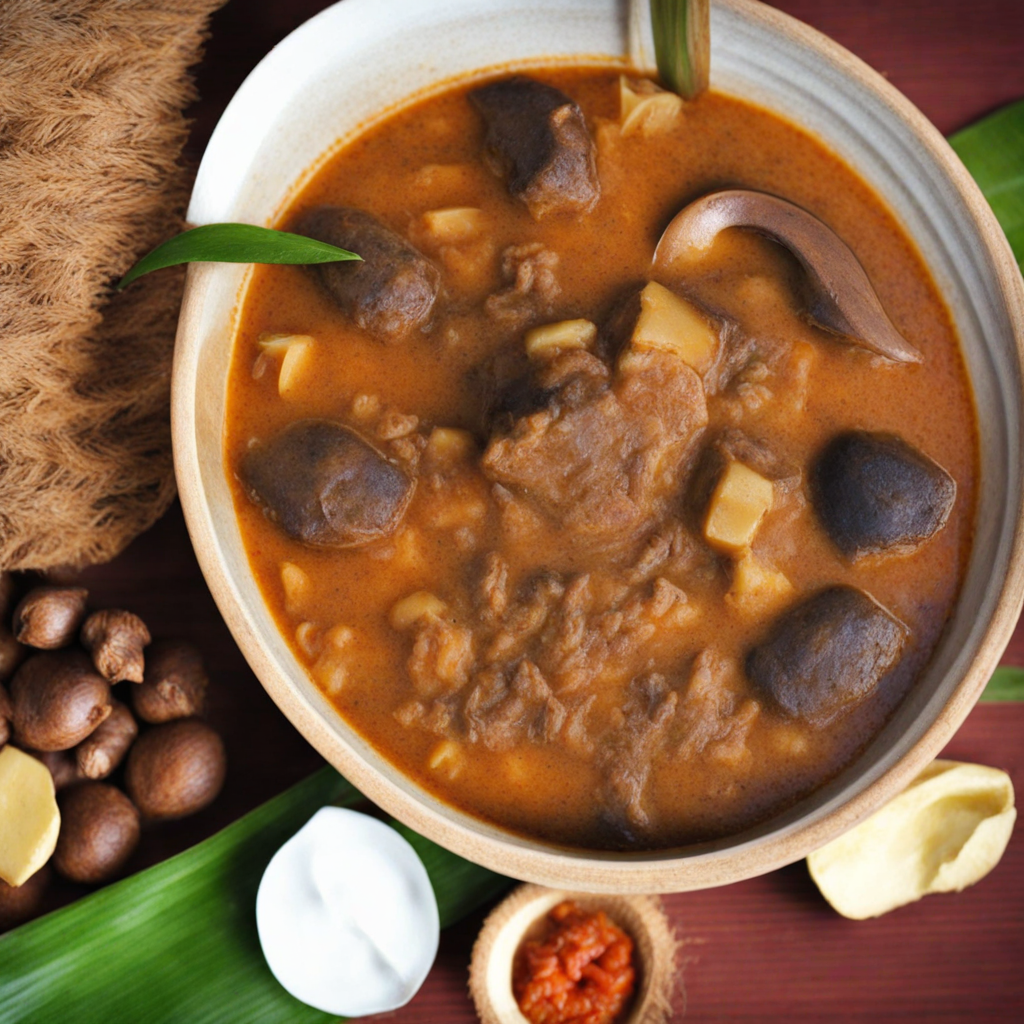Yam Porridge
Yam Porridge, known as "Asaro" in some regions, is a hearty and comforting dish that showcases the versatility of yam, a staple ingredient in Ghanaian cuisine. The dish is typically made by boiling yam until it is tender, then mashing it into a thick, creamy consistency. The yam serves as a canvas for a medley of flavors, with ingredients such as onions, tomatoes, and peppers often sautéed in palm oil or vegetable oil to create a rich, savory base. This combination not only infuses the porridge with vibrant color but also offers a delightful contrast of textures, making each bite a pleasure to savor. To elevate the dish further, Yam Porridge can be enhanced with various proteins, such as fish, chicken, or even beans, which contribute to its nutritional value and heartiness. The addition of spices like ginger, garlic, and ground pepper adds warmth and depth, creating a well-rounded flavor profile that is both satisfying and invigorating. Each family may have its own secret twist, whether it’s a splash of fermented locust beans for an umami kick or a sprinkle of fresh herbs for brightness, allowing for endless variations and personal touches. This dish is not only a feast for the taste buds but also a significant part of Ghanaian culture, often served at gatherings or special occasions. Yam Porridge is typically enjoyed hot, making it an ideal comfort food during cooler weather. Its ability to bring people together around the table and its nourishing qualities make it a beloved dish that embodies the essence of Ghanaian hospitality. When you explore Yam Porridge, you’re not just tasting a meal; you’re experiencing a piece of Ghana's rich culinary heritage.
How It Became This Dish
Asaro: A Culinary Legacy of Ghana #### Origins of Asaro Asaro, also known as yam porridge, is a beloved dish originating from the rich culinary landscape of Ghana, West Africa. The dish primarily consists of yam, a starchy tuber that has been a staple food in the region for centuries. Yam cultivation dates back to ancient times, with evidence suggesting that it has been grown in West Africa for over 5,000 years. The indigenous people of the area have long revered yam for its nutritional value, cultural significance, and versatility in various culinary applications. The name "Asaro" itself is derived from the Akan language, predominantly spoken by the Akan ethnic group in Ghana. The Akan people have a deep-rooted connection to yam, often referring to it as "ɛkɔm" or "nkuto," depending on the specific context. This linguistic connection highlights the importance of yam not only as a food source but also as an integral part of the cultural identity of the Akan people and other ethnic groups in Ghana. #### Cultural Significance In Ghanaian culture, yam is more than just a food; it is a symbol of prosperity, fertility, and communal bonds. It plays a pivotal role in various traditional ceremonies, including weddings, harvest festivals, and rites of passage. The significance of yam is particularly pronounced during the Homowo festival celebrated by the Ga people, where yam is presented as an offering to the gods to ensure a bountiful harvest. Asaro, in particular, is often prepared during communal gatherings and family meals, reinforcing social ties among family members and the community. The act of cooking and sharing Asaro embodies the spirit of togetherness and hospitality that is central to Ghanaian culture. It is common to see families gathering around a pot of Asaro, sharing stories, laughter, and nurturing their bonds over this warm and comforting dish. The dish also serves a practical purpose in the lives of many Ghanaians. Rich in carbohydrates, Asaro provides essential energy, making it a favored meal among laborers and those engaged in physically demanding work. The addition of various ingredients such as vegetables, spices, and proteins elevates its nutritional profile, transforming Asaro from a simple porridge to a well-rounded meal. #### Development Over Time The evolution of Asaro reflects the broader changes in Ghanaian society and its culinary practices. Traditionally, Asaro was prepared by boiling yam until tender and then mashing it to create a smooth, porridge-like consistency. This method of preparation has roots in ancient cooking techniques that have been passed down through generations. However, as Ghana has evolved, so too has the preparation and presentation of Asaro. In contemporary Ghana, Asaro has embraced a fusion of traditional and modern culinary influences. While the basic ingredients remain the same, cooks have begun to experiment with flavors and textures, incorporating local spices such as ginger, pepper, and onions to enhance the dish. Additionally, the use of meats, such as fish, chicken, or beef, has become more common, turning Asaro into a hearty main course rather than just a porridge. One significant change in the preparation of Asaro has been the introduction of technology. While traditional methods relied on open flames and pots, many households now utilize electric stoves and blenders to streamline the cooking process. This modernization has made it easier for families to prepare large quantities of Asaro for gatherings, ensuring that the dish remains a staple during celebrations and communal feasts. #### Asaro in the Diaspora As Ghanaian communities have spread across the globe, so too has the love for Asaro. In the diaspora, Ghanaians have worked to preserve their culinary heritage by introducing Asaro to new audiences. Asaro has found its way into international food festivals, restaurants, and homes, where it is celebrated for its comforting nature and cultural significance. Cooking classes and online culinary platforms have also emerged, allowing individuals outside of Ghana to learn how to prepare Asaro. This cross-cultural exchange has led to creative adaptations of the dish, with chefs experimenting with different ingredients and cooking methods, thus enriching the global culinary tapestry. #### Conclusion: The Legacy of Asaro Asaro stands as a testament to Ghana's rich culinary history, embodying the resilience and creativity of its people. From its ancient origins rooted in the communal practices of the Akan and other ethnic groups to its modern adaptations in kitchens worldwide, Asaro is more than just a dish; it is a symbol of identity, tradition, and community. Asaro's culinary journey reflects the evolving nature of food and culture, highlighting how traditional dishes can adapt and thrive in new contexts while retaining their core significance. As Ghana continues to embrace globalization, the legacy of Asaro will undoubtedly persist, serving as a bridge connecting generations, cultures, and cuisines. In every bowl of Asaro, there is a story waiting to be told—of the land, the people, and the enduring spirit of a dish that has nourished countless souls throughout history.
You may like
Discover local flavors from Ghana







